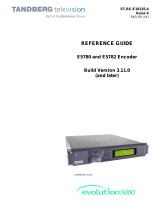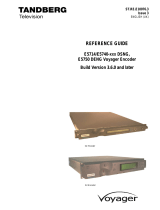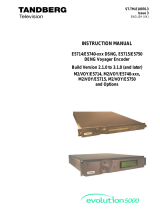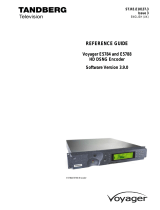Page is loading ...

Crystal Vision Ltd., Lion Technology Park, Station Road East, Whittlesford, Cambridge, CB22 4WL, England.
E-mail: [email protected] Website: www.crystalvision.tv Tel: +44(0) 1223 497049 Fax: +44(0) 1223 497059
ViViD114
SDI variable video delay

ViViD114UserManualV1.0 Crystal Vision
23/10/02
Contents
1 Introduction 1
2 Using the active control panel 2
2.1 Navigating the display 3
2.2 Updating the display 3
2.3 The ViViD114 active panel menu structure 4
Menu numbering scheme 4
2.4 Configuring delay 5
Resetting delay 6
2.5 Input status 6
3 Card edge operation 7
3.1 Selecting the control mode 7
3.2 Configuring delay 7
Resetting delay 8
4 Installation 9
4.1 Rear modules and signal I/O 9
FR2AV, FR1AV & DTBAV rear connectors 9
4.2 ViViD114 configuration 10
5 Problem solving 11
5.1 Card edge status LEDs 11
5.2 Control panel status 11
6 Specification 13

Crystal Vision Introduction
123/10/02
1 Introduction
ViViD114 is a Variable Video Delay which offers up to a second of delay and has been
designed to match system delays elsewhere in an equipment chain.
ViViD114 Video Delay
The main features are as follows:
• passes entire SDI stream, including HANC and VANC
• auto 525/625 selection
• four SDI outputs
• delay adjustable from 30 pixels to 30 frames in 525 and 24 frames in 625 in
increments of fields, lines and groups of six pixels
ViViD114 is a 100mm x 266mm module, which fits in the three standard frames and can
be integrated with any boards from the company’s full product range. It uses the RM01
rear connector.
Applications include virtual studios where ViViD114 can offset the virtual set delay so
the camera feed and graphics both reach the chroma keyer at the same time and
transmission where ViViD114 can compensate for the delay of MPEG encoders or
decoders.

Crystal Vision Using the active control panel
223/10/02
2 Using the active control panel
The Crystal Vision active control panel is available as an integral part of the FP2-LF front
door for the FR2AV 2U frame, the FR1AV frame, and the DTBAV desktop box or as a
remote panel. Only one control panel can be connected to any frame, although one panel
can control two frames.
The Crystal Vision control panel
At power up, the two line 20-character screen will display ‘Crystal Vision’ followed by
the firmware version number for the control panel. Once the control panel is initialised,
each module in a frame is polled. Modules that have completed their own initialisation
will respond with a node address. A node address is a unique number that defines a
module’s position in a rack.
The control panel will display the name of the module that first responds to the polling
request together with its node address.
Control panel showing available cards
To select a particular module in a frame, press the DEVICE key. The top line of the
display will change to show ‘Available Cards X’, where X is the number of cards that
have responded so far to the polling request. Rotating the shaft encoder will cause the
bottom row of the display to cycle through the successfully polled cards by name and
node number.

Crystal Vision Using the active control panel
323/10/02
When the ViViD114 module is selected press the ENTER key to access that module’s
HOME menu.
ViViD114 home menu
Ensure that ViViD114 card-edge switch lever 2 is in the DOWN position to enable
remote control via the active control panel.
Note:
In the 2U frame the node address is calculated in one of two ways:
*slot number minus 1 – giving a range of 0 – 11 in frame #1, OR
*slot number plus fifteen – giving a range of 16 – 27 in frame #2
The two ranges are provided to allow one control panel to control two frames.
In the 1 U frame the address range is 0-5 OR 16-21.
Please refer to the frame manual for further information on node addresses.
2.1 Navigating the display
The control panel keys are assigned the following functions when controlling ViViD114:
• DEVICE – selects a card or module to control
• Asterisk – no function assigned
• F1 to F2 – soft keys, function assigned within each menu
• HOME – moves the display to the home menu
• ENTER – accepts device selection
• CAL – assigns minimum delay value
• Upward arrow – used to move up the menu structure
• Rotary control – shaft encoder used to select options or variable data
2.2 Updating the display
The values displayed on an active front panel are only updated when an adjustment is
made and when changing menu level. If changes occur through the use of card edge
controls or other remote control, the text displayed on the active front panel will not be
updated immediately. If necessary, use the upward arrow to leave and then re-enter a
menu to update the display.

Crystal Vision Using the active control panel
423/10/02
2.3 The ViViD114 active panel menu structure
The main top-level menus for the ViViD114 module are obtained by pressing the F1 and
F2 keys from the HOME menu. Menu keys are illuminated when active and when further
menus are available. The top-level menus are:
• Delay (Configure Pixel, Line Filed and Frame delay) – press F1
• Stats (Status) – press F2
The following chart shows the available menus.
The ViViD114 menu tree
Note:
Function keys and shaft encoder LEDs are illuminated when active.
Menus or function keys associated with the shaft encoder for changing assigned values are
shown with a black circle.
Menu numbering scheme
This manual uses a simple menu numbering convention based on the sequence of keys
required to reach each menu from the top level home menu. For example, menu 1.1.2 is
reached from the home menu by pressing F1, then F2. Menu 1.2.3 is reached by pressing
F2 and then F3.

Crystal Vision Using the active control panel
523/10/02
2.4 Configuring delay
Pressing F1 from the home menu will bring up the delay menu. The delay menu provides
access to the Pixel, Line, Field and Frame sub-menus:
ViViD114 delay menu Description
Provides access to the following sub-menus:
PXEL (Pixel) Menu – press F1
LINE Menu – press F2
FIELD Menu – press F3
FRME (Frame) Menu – press F4
Rotate shaft encoder to set delay in pixels.
LINE/PIXEL menu – press F1
FIELD/LINE menu – press F2
FRAME/FIELD menu – press F3
Rotate shaft encoder to set delay in lines.
PIXE/LINE menu – press F1
FIELD/LINE menu – press F2
FRAME/FIELD menu – press F3
Rotate shaft encoder to set delay in fields.
PIXEL/LINE menu – press F1
LINE/FIELD menu – press F2
FRAME/FRAME menu – press F3
Rotate shaft encoder to set delay in frames.
PIXEL/LINE menu – press F1
LINE/FIELD menu – press F2
FIELD/FRAME menu – press F3
Maximum delay values
625 max values 525 max values
Pixel 858 852
Line 311(field 1) 312 (field 2) 261(field 1) 262 (field 2)
Field 22
Frame 24 28
If the adjustment exceeds the maximum allowed, the value displayed will be reset to zero
and one will be added to the higher value delay menu. This works for all menus, except
Frames.
If an attempt is made to go below zero, one will be subtracted from the lower value delay
menu. This works for all menus, except Pixels. It is not possible to reduce the total delay
of the module below 30 pixels.

Crystal Vision Using the active control panel
623/10/02
All delay variable controls – pixel, line, field and frame - can be accessed from any sub-
menu. Use the F1, F2 and F3 controls to toggle through the available choices. The
variable assigned to the shaft encoder is always shown in the top line of the display.
Resetting delay
Press CAL in any menu to assign the minimum delay value for the variable shown.
2.5 Input status
Status menu Description
Status menu:
INPUT: Present or No Inp
STANDARD: 625 or 525
Note:
The status menu will not change if the input status changes whilst the status display is
shown. To refresh the status display, press the ‘CAL’button.

Crystal Vision Card edge operation
723/10/02
3 Card edge operation
Once the start-up initialisation procedure is complete, the ViViD114 card can be
controlled or configured from the card edge, the active control panel or the Statesman PC
interface (future option). This chapter will concentrate on the card edge controls.
The front edge of the card provides power rail monitoring, menu selection, delay
assignment and a ten-digit visual status display.
ViViD114 front edge view
3.1 Selecting the control mode
The 4-way piano switch allows control options to be selected.
Lever Function Action
All UP Local mode Card-edge control enabled
1 Down CAL Set lever 1 down (and rotate shaft-encoder) to reset delay
2 Down Remote mode Remote control enabled
3 Down N/A No function assigned
4 Down N/A No function assigned
4-Way piano switch menu functions
3.2 Configuring delay
The SELECT control cycles through the HOME and DELAY menus:
ViViD114 card-edge menus
The ADJUST shaft encoder increases or decreases the delay in the given menu.

Crystal Vision Card edge operation
823/10/02
Maximum delay values
625 max values 525 max values
Pixel 858 852
Line 311(field 1) 312 (field 2) 261(field 1) 262 (field 2)
Field 22
Frame 24 28
If the adjustment exceeds the maximum allowed, the value displayed will be reset to zero
and one will be added to the higher value delay menu. This works for all menus, except
Frames.
If an attempt is made to go below zero, one will be subtracted from the lower value delay
menu. This works for all menus, except Pixels. It is not possible to reduce the total delay
of the module below 30 pixels.
SELECT menu Function
Home Shows ViViD114 firmware version
PIXEL XXX Use ADJUST to change delay in pixels
LINE X Use ADJUST to change delay in lines
FIELD X Use ADJUST to change delay in fields
FRAME XX Use ADJUST to change delay in frames
Resetting delay
To reset the currently selected delay in any menu to its minimum value, press piano lever
1 DOWN (CAL) and rotate the ADJUST control. Return the CAL lever to the UP
position to continue delay adjustment.

Crystal Vision Installation
923/10/02
4 Installation
The ViViD114 video delay module is a single height module which fits into all Crystal
Vision rack frames. All modules can be plugged in and removed while the frame is
powered without damage.
4.1 Rear modules and signal I/O
FR2AV, FR1AV & DTBAV rear connectors
The FR2AV 2U frame takes up to 12 single height Crystal Vision modules, 6 single
height modules fit in the FR1AV 1U frame and 2 single height modules fit in the
DTB2AV 1U frame.
RM01 rear module connections:
RM01 fits in FR2AV, FR1AV & DTBAV frames Description
RM01 (ZLA00180 artwork)
• 12 modules per FR2AV, 6
per FR1AV & 2 per DTBAV
frame
• All frame slots can be used
BNC Signal
SDI IN SDI In
SDI OUT(1) SDI output 1
SDI OUT(2) SDI output 2
SDI OUT(3) SDI output 3
SDI OUT(4) SDI output 4
SDI OUT(5) Not used

Crystal Vision Installation
10 23/10/02
4.2 ViViD114 configuration
The jumper links on the board are set correctly when ViViD114 is tested before despatch and should be
left as set at the factory. The following information is for jumper position confirmation only.
ViViD114 showing default factory jumpers
Link positions - board viewed as above
Link Required position
PL2 Must be in the +2V5 position (link pins 1–2)
PL3-6 Not used
PL8 Must be in the +3V3 position (link pins 1-2)

Crystal Vision Problem solving
11 23/10/02
5 Problem solving
Trouble shooting may be performed by using the card edge or remote status panel display.
5.1 Card edge status LEDs
Board edge LEDs provide status reporting and may be useful when fault finding.
The following table summarises the card edge LED functions and colours:
Status Led Colour Description
PSU Green Power supply rail OK
Err Red Invalid input
625/525 Amber 625 (upper) or 525 (lower) input
5.2 Control panel status
The input status is also shown in the STATS menu of the active control panel.
Status menu Description
Status menu:
INPUT: Present or No Inp (No Input)
STANDARD: 625 or 525
Note:
The status menu will not change if the input status changes whilst the status display is
shown. To refresh the status display, press the ‘CAL’button.

Crystal Vision Problem solving
12 23/10/02
Basic fault finding guide
The Power OK LED is not illuminated
Check that the frame PSU is functioning – refer to the appropriate frame manual for detailed
information
There is no video output
Check that a valid SDI is present and that any cabling is intact
Check that SDI OUT(5) is not used, as this is not connected
The video output exhibits jitter
Check that the input SDI stability is within normal limits and that the maximum cable length has not
been exceeded
The card no longer responds to card edge or front panel control
Check that the card is seated correctly and that the Power OK LED is lit
Check any active control panel cabling
Check if the control panel can control another card in the same rack
If necessary re-set the card by simply removing the rack power and re-applying power after a few
seconds or by removing the card from the rack and then re-inserting the card
It is safe to re-insert the card whilst the rack is powered

Crystal Vision Specification
13 23/10/02
6 Specification
General
Dimensions 100mm x 266 mm module with DIN 41612 connector
Weight 180g
Power consumption 5 W
Inputs
Video 270Mb/s serial digital to EBU Tech 3267-E and SMPTE-259M
Cable equalisation >200m Belden 8281 or equivalent
Auto 525/625 selection
Outputs
Number and type: 4 reclocked SDI outputs to EBU Tech 3267-E and SMPTE-259M
Will drive >200m Belden 8281 or equivalent
Processing
Vertical data Passes entire SDI stream, including HANC and VANC
Delay Adjustable in increments of 6 pixels, lines or fields from 30 pixels to 28
frames in 525 and 24 frames in 625
Ordering information
ViViD114 Video Delay For long video processing delays
FR2AV 2U frame for up to 12 modules
FR1AV 1U frame for up to 6 modules
DTBAV 1U Desk top box for up to 2 modules
/




